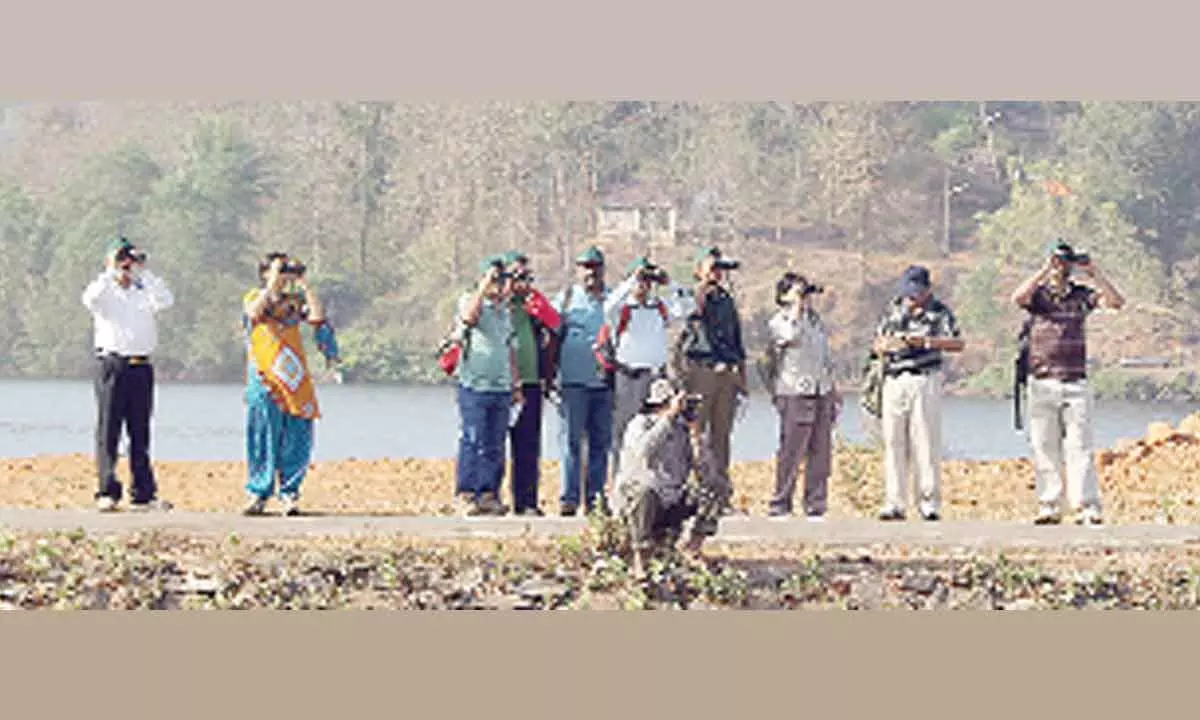Bird watchers affirm seeing 162 species at Kaiga

Nuclear Power Corporation organises bird sighting expedition to prove its plant is safe
Kaiga (Karwar): There have been many debates about the environment suffering due to nuclear power generation. Sometimes one wishes somebody told us the real facts without strings attached, especially when it comes to striking a balance between environmental protection and development.
But in the case of Karnataka, it may not be true as the Kaiga Generating Station (KGS), through various environmental measures, has regenerated the forests thicker than before. As a result, the catchment area of KGS was attracting birds, in stark contradiction to the general notion that radiation several kilometres around the nuclear power station affected bird diversity first. Birders who participated in a "bird sighting expedition" organised by the Nuclear Power Corporation of India Limited (NPCIL) have found that the bird diversity was intact around Kaiga and that it was in fact getting better in the bird population.
Officials of the NPCIL said that "there is a lot of interest generated in environmental protection vis a vis nuclear power. There was an argument that the bird species would be affected very badly if there were leaks in radiation. The increase in the numbers of birds and bird diversity goes to prove that Kaiga was a safe area for all living beings."
"It was a marathon. It extended up to 42 kilometres around Kaiga and birders travelled 6-7 kilometres in various terrains that host birds like aquatic, wetland, grassland, raptor and land birds. A total of 213 species of birds have been identified so far in the area surrounding Kaiga generating station and Kaiga Township in Mallapuram is approximately 17 kilometres from KGS.
On average 162 species of birds were found. I was able to identify an Ashy Drongo, and my friends in my circuit saw a number of migrants " the head of the North Karnataka Birders' Network (NKBN), told.
20 species which have not been identified so far have been observed and documented. What does this mean? When asked, well-known ornithologist Dr N A Madhyastha said the "bird diversity and the population was definitely an indicator of the health of the environment. I would base my argument on endemic bird diversity—those which are commonly found in a certain area. Migrants do come and go, and wetlands birds also go wherever there are wetlands. It was heartening to know that the bird diversity was found to be at its peak at Kaiga".
Bangalore-based ornithologist (of BNG birds-at Yahoo group) said that "We got down from Yellapur through Baare Ghat into the Mallapura-the township of Kaiga Generating Station. We found it no different in bird diversity than any of the western ghats spots."
A few of the species…
• Nilgiri Flowerpecker (Dicaeum concolor),
• Crested Goshawk (Accipiter bivirgatus),
• Rufous-bellied Eagle(Lophotriorchis kienerii),
• Brown Fish Owl(ketupa zeylonensis),
• Blyth's Starling(Sturnia malabarica(blythi),
• Crested Caracara,
• Treeswift (Hemiprocne coronate),
• Clamorous Reed warbler (Acrocephalus stemtoreus),
• Peregrine Falcon (Falco peregrinus),
• Besra (Accipiter virgatus),
• Oriental Honey Buzzard (Pernis ptilorhynchus),
• Scaly Breasted Munia (Lonchura punctulata),
• Changeable Hawk Eagle (Nisaetus (cirrhatus) limaets)
• All three Hornbills: Malabar Pied Hornbill (Anthracoceros)
• Indian Gray Hornbil (Ocyceros birostris) and
• Malabar Grey Hornbill (Ocyceros griseus).
• Migrants like Grey Wagtail (Motacilla cinerea),
• Brown Shrike (Lanius Verditer (Dicrurus cristatus),
• Ashy Drongo (Dicrurus leucophaeus),
• Red-rumped Swallow (Cecropis daurica),
• Barn Swallow (Hirundo rustica).

